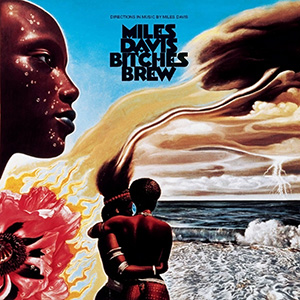
This week, I’ve been listening to Miles Davis’s double-album “Bitches Brew” from 1970. I spent time with Davis’s album “Kind of Blue” last year, which I enjoyed even if I wasn’t sure how to understand it. He once again challenges me in a different way, with this album. Here the band creates more of an other world through sound and rhythm. When I was in college studying fine art, I would often play this album in the painting studio. “Bitches Brew” providing an interesting, but unobtrusive, atmosphere that encouraged my own focus and creativity.
These are musical pieces without vocals that eschews techniques commonly used in music to make songs immediately digestible. There’s no hooks, clear melodies, or obviously repeated motifs for the listener to grab unto. That’s not to say that there’s no melody or motifs, or even hooks. They don’t come forward at once, but require time and repeated listening to reveal themselves. Just as these long (the title track is just over 26 minutes) pieces evolve within themselves, a feeling for them also evolves within the listener through repeated exposure.
Bitches Brew
This double LP opens with two very long tracks that took up a full side of a vinyl record. The 20 minutes track “Pharoah’s Dance” opens the album, while “Bitches Brew” fills the second side with a lengthy 26 minutes. Engineers like to keep the side of a record to 22 minutes or less, due to physical limitations of a 12 inch record. Above 22 minutes, the grooves have to get tighter, resulting in a gradual loss of sound quality. It’s also a long time to listen to a single piece of music.
Most of my listening to these albums happens in the car while driving, which means that I often did not hear these all in one sitting, but rather broken up into pieces. I do listen to these some at work in headphones, but that is less focused listening. That’s a shame, because this album really opens up in headphones.
On this album, we often hear two drummers and two bassists simultaneously playing. These pairs are panned hard left and hard right; With headphones, we can clearly hear the rhythms interweaving back and forth, supporting each other in creating complex textures. Two keyboardists at electric pianos also interact in the same way across the stereo field. I was overwhelmed at first by how much was going on where there’s typically a much more straight-forward simple foundation being laid out. Here that foundation is constantly evolving, undulating, and folding in on itself.
It allows for the players to come in and out of the basic down-beat and up-beat to perform complex rhythms knowing that their counterpart can support the beat until they come back. At times, the drums feel chaotic and then meld into a complex fabric bed, or an alien landscape, over which travels the electric guitar, trumpet and saxophone.
At the start of this the track “Bitches Brew,” the trumpet plays into a tempo-synced delay echo effect bouncing from right to left.Staccato blasts of trumpet echoed, creating an opening rhythm and atmosphere. Drums, electric piano and bass tumble out of these blasts, rolling and collapsing. This builds into the song that then takes us on a journey into the brew.
Spanish Key
The second LP opens with “Spanish Key,” which is a little more rocking than atmospheric, at least at first. The basses throb at a persistent galloping rhythm from the start. A brushed snare, shakers, and tambourine build up the rhythm, followed by loosed rolls across the toms. Sparse, mellow, short melodic motifs on the trumpet begin to evolve, growing into extended melodies. The electric piano quietly adds harmony. Saxophone grows, like a drone fading in and out. Three minutes into the track, rock-influenced lightly-overdriven electric guitar shuffles, scratches rhythms and scuttles. Occasionally that guitar hints at melody, bending notes and short blasts of solo riffs.
Just as these excursions flirt with flying into outer-space chaos, the instruments join into a simultaneous rhythmic cadence, then pause. A trumpet or bass may then continue on while the other instruments rest. The piece returns to Earth, momentarily. This cadence becomes motif of the song, repeated at the end of these phrases as a reminder where we are.
The tracks on this album make use of this technique often. There’s a motif: rhythmic, melodic, or both, that the band joins in to ground the piece before it loses the listener in chaos. This is followed by the band calming down for a moment, the drums and bass relax, but then the melodies and harmonies get folded, interpreted, transformed used as a basis for apparent improvisation. Then things evolve, rising in intensity, which often involves, pitch, tempo, texture, and rhythm. With multiple instruments doing this, they journey beyond and away from each other, while retaining some sense of interplay.
I don’t know if, or how, any influence from this album might show up in my own music, but I’ve definitely enjoyed getting an introductory experience with it. Miles Davis expands my feelings on what music can do, even when I don’t understand what he’s doing from a critical or technical standpoint.